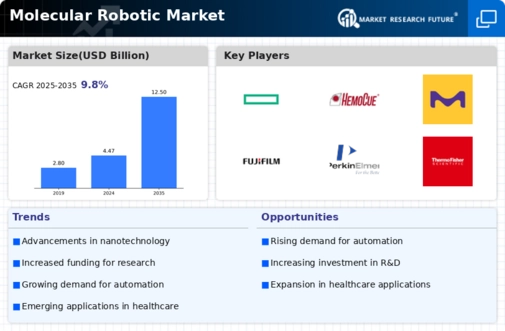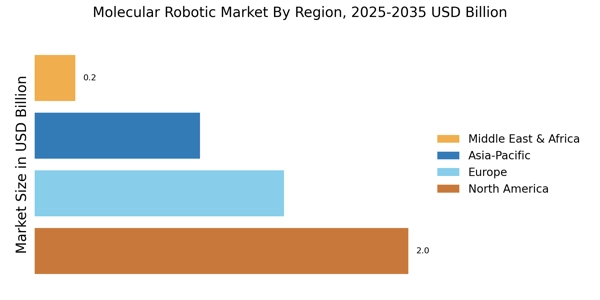Rising Demand for Automation
The increasing demand for automation across various sectors is a pivotal driver for the Molecular Robotic Market. Industries such as manufacturing, healthcare, and logistics are increasingly adopting robotic solutions to enhance efficiency and reduce operational costs. According to recent estimates, the automation market is expected to grow at a compound annual growth rate of 10% through 2027. This trend suggests that molecular robotics, which offers advanced automation capabilities, will likely see heightened interest from businesses aiming to streamline processes. Moreover, the integration of molecular robots in automated systems can lead to improved accuracy and reduced human error, further solidifying their role in the evolving landscape of automation. As organizations continue to seek innovative solutions, the Molecular Robotic Market stands to benefit significantly from this growing demand.
Advancements in Nanotechnology
The Molecular Robotic Market is experiencing a surge due to advancements in nanotechnology. These innovations enable the development of molecular robots that can manipulate materials at the atomic level, leading to enhanced precision in various applications. For instance, the integration of nanotechnology in drug delivery systems has shown promising results, potentially increasing the efficacy of treatments while minimizing side effects. As of 2025, the market for nanotechnology in healthcare is projected to reach approximately 200 billion USD, indicating a robust growth trajectory. This growth is likely to drive investments in molecular robotics, as companies seek to leverage these technologies for improved healthcare solutions. Furthermore, the ability to create nanoscale robots opens new avenues for research and development, thereby expanding the scope of the Molecular Robotic Market.
Growing Focus on Precision Medicine
The shift towards precision medicine is significantly influencing the Molecular Robotic Market. As healthcare moves away from one-size-fits-all approaches, there is an increasing need for tailored treatments that molecular robots can facilitate. These robots can analyze genetic information and deliver personalized therapies, potentially improving patient outcomes. The precision medicine market is projected to reach over 100 billion USD by 2026, indicating a robust growth potential that molecular robotics can capitalize on. Additionally, the ability of molecular robots to perform complex tasks at the molecular level allows for more targeted interventions, which is essential in the development of effective treatments. This trend underscores the importance of molecular robotics in advancing healthcare solutions and highlights its growing relevance in the Molecular Robotic Market.
Increased Investment in Research and Development
Investment in research and development is a crucial driver for the Molecular Robotic Market. As organizations recognize the potential of molecular robotics, funding for R&D initiatives has seen a marked increase. In 2025, it is estimated that global spending on robotics R&D will exceed 50 billion USD, reflecting a strong commitment to innovation. This influx of capital is likely to accelerate the development of new molecular robotic technologies, enhancing their capabilities and applications. Furthermore, partnerships between academic institutions and private companies are fostering collaborative research efforts, which may lead to breakthroughs in molecular robotics. Such advancements could pave the way for novel applications in fields such as drug discovery, environmental monitoring, and materials science, thereby expanding the reach and impact of the Molecular Robotic Market.
Emerging Applications in Environmental Monitoring
The Molecular Robotic Market is also being propelled by emerging applications in environmental monitoring. As concerns about climate change and pollution intensify, there is a pressing need for innovative solutions to monitor and address environmental issues. Molecular robots can be deployed to detect pollutants at a molecular level, providing real-time data that can inform policy and remediation efforts. The environmental monitoring market is expected to grow significantly, with estimates suggesting it could reach 30 billion USD by 2027. This growth presents a unique opportunity for molecular robotics to play a pivotal role in environmental sustainability initiatives. By enabling precise monitoring and analysis, molecular robots can contribute to more effective environmental management strategies, thereby enhancing their importance within the Molecular Robotic Market.


















Leave a Comment